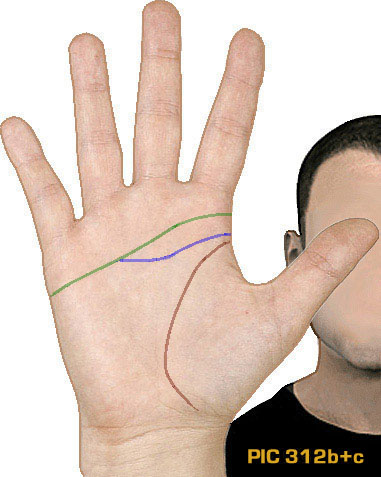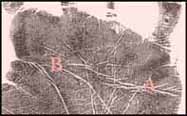
How to recognize simian lines?
- Simian Crease (2/14): How to recognize- and discriminate it's related- and non-related manifestions! -
![]() SIMIAN LINE INDEX (14 sub-sections):
SIMIAN LINE INDEX (14 sub-sections):
INTRO: The simian line: a minor physical anomaly!
• HOW TO RECOGNIZE Simian Lines?
• WHY THE NAME Simian Line?
• HISTORY of the Simian Line
• ETHNICITY & the Simian Line
• HEALTH & the Simian Line
• PSYCHOLOGY & BEHAVIOR: the Simian Line
• BIG FIVE PROFILING: personality & Simian Line
• PSYCHODYNAMIC PROFILES: the Simian Line
• HAND SIGN TUTOR: Simian Line - quick summary
• FAMOUS PEOPLE with Simian Lines [80+ celebs]
• PROJECTS related to the Simian Line
• ONLINE READINGS for the Simian Line
• SYNONYMS for the Simian Line
The use of the notorious simian line ('single palmar crease') as a diagnostic marker requires a proper understanding of the underlying concept + the major hand lines. This article describes the concept of the simian line + how to recognize- and discriminate it's related manifestions.
In order to make a proper assessment, it is important to focus on the 'core' of the major lines involved which require a width of more than two time the epidermal groove width.
The final section of the article describes how to separate (in)complete simian lines from transitional- and pseudo variants with a series of illustrations!

The human hand usually shows two major transverse creases (which are still present in transitional variants).
However, in a 'complete simian line' there is only a single crease present, leaving the impression that something appears to be missing!
The concept of the simian line by detail!
Usually the human palm of the hand is featured with 3 strong major lines, in medical science these are often referred to as: palmar flexion creases. The lines involved are known as (see left hand below):
1 - life line [radial longitudinal crease];
2 - head line [proximal transverse crease];
3 - heart line [distal transverse crease].


However, sometimes the 2 horizontal transverse creases (= head line & heart line) manifest as a single FUSED line, which typically leaves the impression that something appears to be MISSING in the upper zone of the palm of the hand. This rather typical palmar line variant is known as the simian line (in medial science a.k.a. 'simian crease' or 'single transverse crease').
In a 'complete' simian line the (fused) line covers the full palm in a horizontal plane, involving the zone between the thumb and index finger and the zone below the little finger (see the red line in the right hand above).
NOTICE: Minor palm creases are defined as palm creases which are narrower than the two times of the epidermal groove width (according Park et al., 2010).
Beyond 'complete' simian line variants one can also discriminate 'incomplete' simian line variants, which basically represent a minor variant of the 'complete' simian line.
Apart from these two major simian line variants, one can also discriminate two related variants where some of the essential characteristics of a typical simian line is not present. In the so-called 'transitional' variant there is not really 'something MISSING', and in the so-called 'pseudo' variant the aspect of a 'fusion' is not present.
Using the approach described above results in the following 4 categories in the perspective of for separating 'simian line' constellations from 'non-simian line' constellations:
• 'complete' simian lines
• 'incomplete' simian lines
• 'transitional' lines (= look-a-like, but technically not a simian line)
• 'pseudo-simian' lines (= look-a-like, but technically not a simian line)
(A 5th category is optional: • normal/other lines)
Finally, in order to achieve a fundamentally correct assessment it is also important to be aware of the concepts involving some 'other' unusual major line variants which also leave the impression of a line transversing the full palm. The most common variants of such (non-simian) line constellations involve in respective: the Sydney line, the extended heart line, and the Suwon crease - which all three can also be discriminated from a simian line: see picture below.
More details:
• Family tree of (aberrant) palmar transverse crease variations!


Advanced family tree of abberant transverse crease variants!

How to recognize 'complete' simian lines?
A 'complete' simian line can typically be recognized by the presence of a series of characteristics.
Five typical hand characteristics of a 'complete' simian line:
• 1 - there is only one major horizontal line, which may display signs that the line be recognized to represent a fusion of the heart- and head line!
• 2 - one of the two major horizontal creases appears to be missing!
• 3 - above- or below the line there is no other (likewisely strong) horizontal line located covering more than half of the palm width!
• 4 - the line reaches the edge of the palm at the ulnar side (usually just below the palmar knuckle of the little finger).
NOTICE: Be aware that a simian line can show up in many different shapes and related manifestations such as small connected- or disconnected remnants. When a line has only 4 of these 5 characteristics, it might still represent a 'complete' simian line - however, sometimes itbetter fits with the major characteristic seen in an 'incomplete' simian line, which requires a 'splitting' inside the core of the line (more details are presented in the next paragraph).
The 3 photos below represent examples of 'complete' simian lines (click for larger versions):
'COMPLETE' SIMIAN LINES (4 variants): The 'PIC model' describes up to four separate variants for a 'complete' simian line! 



Inside the PIC model there are 4 variants that can all be described to represent a variant of a 'complete' simian line:
|
How to recognize 'incomplete' simian lines?
The MAJOR CHARACTERISTIC of 'incomplete' simian lines is that in these variants the heart line & the head line are clearly only partly fused featured with a SINGLE splitting inside the 'core' of the involved lines!
Usually the 'incomplete' simian line variants are featured with a clear manifestation of a splitting inside the core of the (simian) line, which can either manifest with the presence of a normal heart line, or the presence a normal head line.
Because of these characteristics, the first 3 characteristics of the 'complete' simian line (see the list of 6 characteristics in the preceeding paragraph) is usually not present in an 'incomplete' simian line.
NOTICE: In the perspective of hand diagnostics the 'incomplete' simian line can be recognized to bare likewise significance as the 'complete' simian line!
The 3 photos below represent examples of 'incomplete' simian lines (click for larger versions):
'INCOMPLETE' SIMIAN LINES (8 variants): The 'PIC model' describes up to eight different major hand line variants that all can be recognized as examples of an 'incomplete' simian line! 







Inside the PIC model there are 8 variants that can all be described to represent a variant of an 'incomplete' simian line:
|
How to recognize 'transitional variants'?
(= no simian line!!!)
The MAJOR CHARACTERISTIC of 'transitional variants' (see the 'Normal 3' & 'Normal 4/Simian4' variants in the picture at the top of this article) is that in these variants the normal shape of a heart line- & the head line are present combined with the presence of a 'bridge' - which appears to connect both lines.
In these variants there is no true 'fusion' between the palmar transverse crease, instead there are TWO different splittings present. Therefore, for fundamental reasons it is recommended to exlude these 'transitional variants' from the category 'simian lines'.
In 'transitional variants' the amount of FUSION between the lines involves only a relatively small part of the constellation. Technically one can argue for those 'transitional variants' that nothing is really MISSING, and therefore the essential characteristic of a simian line is not present.
The 3 photos below represent examples of 'simian-bridged' lines (click for larger versions):
NOTICE: In the perspective of advanced considerations, it is important to be aware that in general 'minor bridges' usually should not get associated to represent the 'core' of the major hand lines - basically because these lines in isolation do not have enough width to be recognized as such. Nevertheless, sometimes the combination of multiple 'minor bridges' together can be recognized to represent one (splitting) branch of the 'core'; though in such cases one should also consider whether the combined 'minor bridges' have likewise strength as seen in the other parts of the transversal lines. Only when these combined 'minor bridges' have equal- or more strength than the other splitting branch(es) of the 'core', then these should be recognized to represent the presence of a 'simian-bridged' line. Finally, for proper understanding it is useful to be aware that 'minor bridges' can be spotted in many hands where both the heart- and head line have a perfectly normal shape; this explains why 'minor bridges' usually should not get associated to represent a simian line - especially not in cases where these lines actually CROSS THROUGH the major creases!
How to recognize 'pseudo-simian' lines?
(= no simian line!!!)
Next to the example of 'simian-bridges' there is a different variant should not be taken to represent true simian lines; here we can discriminate two sub-variants:
• 'proximal directed' heart lines, where the heart line progresses on the radial side towards the headline but without a 'core' that makes a full connection with the head line; the length of the heart line is typically relative short, and often featured with a disconnected remnant above located more towards the radial side of the hand.
• 'distal directed' head lines, where the head line progresses on the ulnar side towards the heart line but without a 'core' that makes a full connnection with the heart line; the length of the head line is typically relative short, and often featured with a disconnected remnant below located more towards the ulnar side of the hand.
NOTICE: Even though these variants may have a simian-like appearance, the details regarding the 'core' of the two lines involved show that in both sub-variants the major lines involved can be described to show no clear signs of a FUSION (nor any of the four other typical characteristics described for a 'complete' simian line). As a matter of fact, in these variants the 'core' of both major hand lines involved can be described to stand on it's own.
Photos below represent examples of 'pseudo-simian' lines; photo 1 & 2 show examples of a 'proximal directed heart line', and photo 3 & 4 show examples of a 'distal directed head line' (click for larger versions):
NOTICE: In the perspective of advanced considerations, on fundamental grounds one can safely ignore parts of the major creases that are narrower than the two times of the epidermal groove width (because such parts have likely an impact that is similar to the minor creases).

One of the examples below is not a 'simian line'... can you find it?
Why was the name of the simian line (simian crease) named after simians/primates? ...more.
Other recommended sources:
• Anthropology Of Crease Morphogenesis: A Scientific Analysis - by: R.S. Bali
• 80 Photos of simian lines (presented by: Larry Rodrigues)
- Next simian line section -
Why the name simian line?















